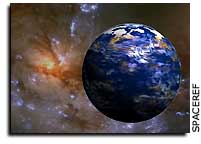The Goldilocks effect: How other earths form just right
 What does it take to make an Earth-like planet? It takes a stellar nursery rich in carbon, oxygen, iron, and silicon in a combination that’s not too much, and not too little, but just right.
What does it take to make an Earth-like planet? It takes a stellar nursery rich in carbon, oxygen, iron, and silicon in a combination that’s not too much, and not too little, but just right.
But these elements didn’t exist right after the “big bang” 13 billion years ago. They began to form in abundance in a strong burst of star formation that lasted a few billion years, and the creation of Earth-like planets became possible. But there is a catch. Too many of these ingredients seems to be a bad thing for Earth formation. The 50 or so huge extrasolar planets that we know about are in orbits that would destroy any Earth-like planets. Dr. Charles H. Lineweaver, Research Fellow at the University of New South Wales, calls this a Goldilocks effect: “with too few ingredients Earths are unable to form, with too many, giant planets destroy any Earths trying to form.”
Lineweaver will present his research, ” Formation of Terrestrial Planets in the Universe: the First Critical Transition,” at the Earth Systems Processes conference on Wednesday, June 27, in Edinburgh, Scotland. The Geological Society of America and the Geological Society of London will co-convene the June 24-28 meeting.
Although the Earth is 4.55 billion years old, by cosmic standards the Earth is the new kid on the block. By combining observations of extrasolar planets and the rate of star formation in the Universe, Lineweaver has discovered that compared to other Earth-like planets in the Universe, our Earth is extremely young.
In a paper in press at the planetary science journal Icarus, Lineweaver reported that “three quarters of the Earth-like planets in the Universe are older than the Earth and their average age is 1.8 (plus or minus 0.9) billion years older than the Earth.”
Although the analysis is about terrestrial planets, not the life on them, Lineweaver concluded that “If life forms readily on Earth-like planets–as suggested by the rapid appearance of life on Earth–this analysis gives us an age distribution for life on such planets and a rare clue about how we compare to other life which may inhabit the Universe.” The “rare clue” is this: most of the life forms in the Universe have had two billion years longer to evolve than we have. (To put this time span in perspective, two billion years ago our ancestors were amoebas.)
Lineweaver’s presentation at Earth Systems Processes includes an update on the age distribution of terrestrial planets in the universe using data from the most recent planet detections and new estimates of the star formation rate. (For earlier work on this topic, see: http://xxx.adelaide.edu.au/abs/astro-ph/0012399.)
CONTACT INFORMATION
Contact: Ann Cairns
acairns@geosociety.org
303-447-2020 x1156
Geological Society of America
During the Earth System Processes meeting, June 25-28, contact the GSA/GSL Newsroom at the Edinburgh International Conference Centre for assistance and to arrange for interviews: 44-131-519-4134
Ted Nield, GSL Science and Communications Officer
Ann Cairns, GSA Director of Communications
The abstract for this presentation is available at:
http://gsa.confex.com/gsa/2001ESP/finalprogram/abstract_7981.htm
Post-meeting contact information:
Dr. Charles H. Lineweaver,
Astrophysics
University of New South Wales
Sydney N/A 2052 Australia
EMAIL: charley@bat.phys.unsw.edu.au
PHONE: 61-2-9385-5168
FAX: 61-2-9385-6060
Ted Nield
Geological Society of London
44-20-7434-9944
ted.nield@geolsoc.org.uk
Ann Cairns
Geological Society of America
01-303-447-2020 ext. 1156
acairns@geosociety.org









